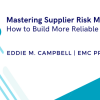Pursuing Data-Driven Insights? Start With Your Supplier Data
For years, experts have urged business leaders to prepare for the coming AI disruption. Realizing the amazing potential of these emerging technologies, they argued, would require businesses to overhaul how they manage data. Yet with the economy booming, many found it easier to push tricky data questions into the future.
Fast-forward to 2020. The COVID-19 pandemic and trade conflicts have upended entire business models. Across industries, the most resilient businesses are those with a strong handle on their data, using real-time information on consumer behavior and inventories to make strategic pivots. Investors have taken notice, as research on the S&P 500 shows stock prices are increasingly correlated with the value of “intangible assets,” such as proprietary data.
In response, many companies are fast-tracking what had been long-term plans for digital transformations, hoping advanced data capabilities will secure their place in a technology-fueled economy. Yet many would be wise to first improve their data practices to ensure the fundamentals are in place for transformation success.
Data Management for (Enterprise) Beginners
To reform data quality, many businesses are turning to the growing market for Master Data Management (MDM) solutions. MDM aims to improve uniformity, accuracy and governance of attributes relevant to an enterprise’s stakeholders. Essentially, this means creating a master record for data on the critical aspects of a business. However, MDM only brings full benefits when rolled out across the entire enterprise — a potentially daunting prospect.
A more accessible strategy would prioritize business functions that stand to gain the most from improved data standards, such as procurement. With Supplier MDM, a sub-discipline of MDM, companies can upgrade their supply network practices while providing a starting point for broader data management endeavors.
By creating processes, establishing accountability and setting standards for data integrity, Supplier MDM creates a “single source of truth” for all essential supplier information. When done right, Supplier MDM can improve supply chain visibility and streamline reporting. Facilitating connections between data points also creates the conditions for successful implementation of new technology such as automation.
Verified Data at the Source
Traditionally, finding supplier data has often meant time-consuming manual searches, with results often undermined by language barriers, outdated database records, or human errors or bias. AI methods now use millions of data points to bring together up-to-date product data, financials, corporate and geographic news, corporate sustainability data, active certifications, etc. The overall result is that supplier management can now be sustained with optimal quality data at all times.
The Perils of Mismanaged Supplier Data
Why is supplier data so critical? In many cases, businesses underestimate the complexity that underlies seemingly basic information like addresses, contact information, bank details and certificates. Often, inaccurate and outdated records are held in various databases across multiple departments, with no clear ownership over either the data or the maintenance process. This results in flawed reporting, impaired analytics and lost trust with stakeholders.
Even slight errors can lead to serious headaches. For example, misspelling a vendor name creates duplicate entries in a supplier database, making it difficult to assess spend analysis at a glance. At best, rectifying this mistake will require extra effort to consolidate the information. More worrisome is the possibility that leadership makes critical business decisions based on incorrect numbers — all because of a wrongly placed keystroke.
Lack of coordination around data also leads to missed opportunities. Consider departments within an organization that use the same supplier on different contracts, instead of leveraging volumes for better pricing or payment terms. Innovative solutions to these communication problems face their own data hurdles; while there are AI tools that could flag such cost savings, they require correctly labeled data for proper analysis.
5 Steps to Effective Supplier Master Data Management
Clearly, the risks of poorly governed supplier data are severe and growing. How, then, can companies pilot successful Supplier MDM initiatives?
Build Your Team
Supplier MDM is not the sole province of procurement. As a process with touchpoints across the entire enterprise, it must be overseen by a cross-functional team of dedicated data stewards.
These data stewards will set standards for quality and integrity at every stage of the supplier lifecycle from data entry to output, including setting uniform data fields and formats and establishing processes for reporting, updating and verification. Dedicated members of this team will also oversee supplier onboarding procedures, direct data maintenance approvals, and determine how to address irregularities or missing information.
Conduct a Self-Assessment
First, the data governance team should review current supplier management processes and assess how well they fit the organization’s evolving needs. The team should document which metrics are being measured and how data is being recorded and used for reporting, especially for growing priorities like sustainability. From the beginning, it is critical to engage every domain that has a touchpoint with suppliers, like finance.
Prioritize Supplier Onboarding
The start of a new business relationship provides an opportunity to lay the groundwork for later success. This is due to the complex but routine work involved at this stage of the supplier lifecycle, including reviewing compliance practices, risks and certifications. Effective Supplier MDM streamlines these tasks by, for instance, pinpointing if the supplier requires a new setup or if there is an existing relationship elsewhere in the organization.
Before any business line collects new supplier information, the request should be reviewed according to the data governance team’s approval process, followed by another level of review before entry into enterprise resource planning, procure-to-pay or other systems.
Simplify Updates
Typically, various teams make ad hoc updates to internal records as soon as they hear of product or personnel turnovers or other supplier changes, without considering the downstream impacts. For this reason, control processes are a core component of a Supplier MDM structure. Designating responsibility to specific users from each function for their data records ensures the appropriate review occurs.
The best Supplier MDM frameworks incorporate both internal and external reviews. This can be done by delegating accountability in vendor contracts or establishing dedicated data portals.
Deactivate, Never Delete
Disengaging with a partner is a natural part of doing business. Yet deleting a record can interrupt data flow to other stakeholders, such as hiding information on dashboards or removing data needed for audits. The supplier data process should involve multiple stakeholder approval levels before deactivation or access to internal portals is revoked. It is equally important to document why a relationship was terminated to inform any future due diligence.
Future-Proofing With Supplier Data
Supplier MDM is an ongoing process. As companies come to view their data as a core business asset, the data governance team will face complex questions around data governance and domain-specific issues like regulatory compliance. Once procurement data governance teams are up and running, they can support the rest of the organization’s larger MDM platform. With experience under their belts, these leaders will be well-positioned to instill a culture of data awareness and openness to innovation across the whole organization.









